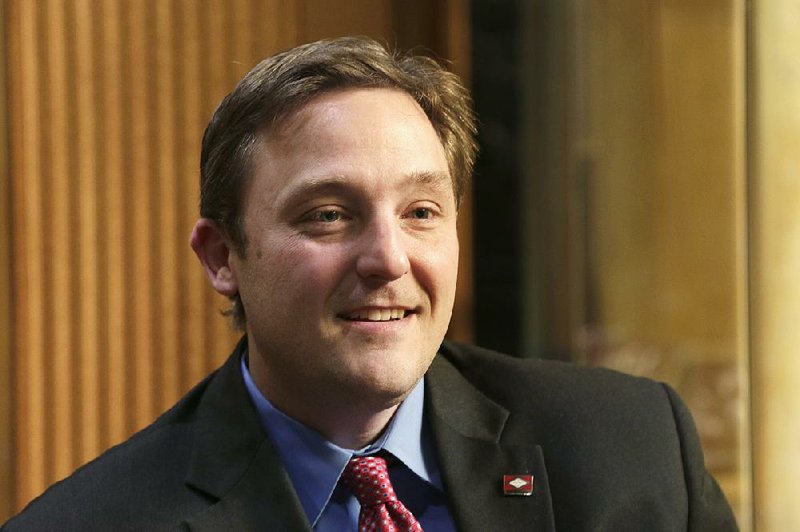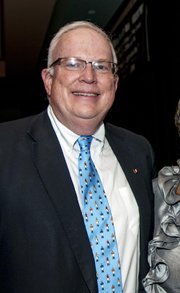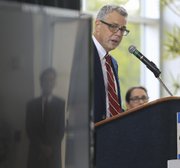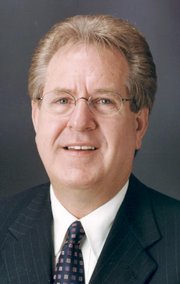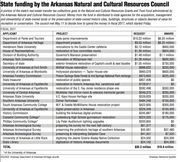About two months before a state council granted nearly $20 million in conservation and historic preservation funds to various government agencies, one of the council’s 11 members, Rex Nelson, advised a colleague that he would push for a request from the state House of Representatives.
“I will be going to bat for this one come May — Rex,” Nelson wrote in an email dated March 7 to fellow member Stacy Hurst, referring to the House’s request for $1.58 million to fix up committee rooms at the Capitol.
Nelson and Hurst, both of Little Rock, serve on the Arkansas Natural and Cultural Resources Council. Nelson was appointed to the panel in March 2015 by House Speaker Jeremy Gillam, R-Judsonia. Hurst serves on the council by virtue of being the director of the Department of Arkansas Heritage. Republican Gov. Asa Hutchinson appointed her to the director position, where she has served since January 2015.
Other members of the council were appointed by a governor or legislative leaders; or serve because of their affiliations with the Parks and Tourism Department and the Heritage Department; the Parks, Recreation and Travel Commission; the Natural Heritage Commission; or the land commissioner’s office.
The council was created in 1987. Its mission and makeup allow its members to vote on requests for funds that benefit the interests they represent or who appointed them.
State law directs the council to use its funds — from a real estate transfer tax — for acquisition, management and stewardship of state-owned lands or the preservation of state-owned historic sites, buildings, structures or objects. The council also can spend money on objects determined to be of value for recreational or conservation purposes.
The council generally meets four times a year.
While it distributed $19.6 million in grants for fiscal 2017, it handed out $18 million in grants in fiscal 2016, according to Department of Arkansas Heritage records. The amounts distributed have exceeded these levels during real estate booms and fallen short during recessions, said former Parks and Tourism Director Richard Davies.
HOUSE REQUEST
Nelson sent the email to Hurst on March 7, six minutes after he received an email from House staff member Patrick Ralston that included the House’s application for the funds and talking points about the request, according to records obtained under the Arkansas Freedom of Information Act. This is the first time that the House has requested funding from the council, House spokesman Cecillea Pond-Mayo said.
During its May 11 meeting, the council granted the House $824,000 of its $1.58 million request for Rooms 130, 138, 149 and 151 on the north side of the state Capitol.
At that meeting, the council reviewed 26 applications seeking a total of $36.2 million in funding, then approved 22 requests totaling $19.6 million, according to its records. The council often funds agencies’ projects in phases.
The largest grants approved were $6.25 million to the Department of Arkansas Heritage for various projects, $6.2 million to the Department of Parks and Tourism for parks improvements, $1.1 million for the Governor’s Mansion and $750,000 to Republican Secretary of State Mark Martin for exterior limestone restoration of the south and east facades of the Capitol.
But the council declined to provide any money to state Treasurer Dennis Milligan, who requested $857,406 for restoring and rehabilitating the public spaces in the treasurer’s office on the second floor of the Capitol.
It also declined to fund one of the three requests submitted by the University of Arkansas at Fayetteville, one of three requests submitted by the Arkansas Archeological Survey and a request from Phillips Community College.
Nelson, a self-described Arkansas history aficionado, said he supported granting the House funds to rehabilitate and restore the committee rooms because a lot of money from the council has been spent improving the Capitol.
According to the Department of Arkansas Heritage records, the secretary of state’s office, in charge of maintaining the Capitol, has received more than $9 million in council grants for various projects at the building.
The office has received these grants since 2001, with the largest grants of $1.2 million in 2008 for repair and restoration of the Capitol’s exterior stone, $1 million in 2006 for exterior restoration and repairs of the Capitol dome, and $1 million in 2016 for historic mural protection and barrel vault rehabilitation.
“Stepping back into those committee rooms is like stepping back into the ’70s,” said Nelson, who is the corporate communications director for Simmons Bank, a columnist for the Arkansas Democrat-Gazette and a former aide to then-Gov. Mike Huckabee, a Republican.
“I’m not aware of any changes in those committee rooms since then [the 1970s],” he said. “I don’t think those were up to the caliber of the rest of the state Capitol. If you look at the projects presented, that was one that needed to be addressed first in the Capitol.”
Gillam said renovation of Rooms 149 and 151 will begin in August and must be completed before the start of the regular legislative session in January. In addition to the $824,000 grant from the council, the Legislature’s Joint Committee on Legislative Facilities authorized spending $175,000 from the Bureau of Legislative Research’s Committee Rooms Fund on the project.
Gillam said the House plans to seek another grant next year from the council to renovate Rooms 130 and 138.
He said the idea to apply for this year’s grant came up long after he appointed Nelson. He said someone suggested that the House committee rooms needed work and that the House should submit a grant application to the council.
“It was logical,” Gillam said.
TREASURER DENIED
Nelson said he would have liked to provide some funding to the treasurer’s office to get its project started, but the majority of the council members thought “that wasn’t a good upgrade.”
Asked about the decision on Milligan’s request, council member Kane Webb put it this way: “You had the treasurer. You had the state Capitol itself. You had the House committee rooms and then you had the Governor’s Mansion, and we thought … the House committee rooms needed the money more than the treasurer did [and] the state Capitol needed some.
“I thought the treasurer could wait on his because it didn’t seem like it was in that bad of shape,” said Webb, who serves on the council as the current director of the state Department of Parks and Tourism, a job to which he was appointed by Hutchinson in October.
Milligan, a Republican, said his office has unsuccessfully applied for grants for two years in a row to restore the public spaces to the way they were decades ago. The council hasn’t previously awarded the treasurer’s office any funds, according to the Department of Arkansas Heritage records.
“Unfortunately for us, the Legislature had some demands and the secretary of state [requested money], and we just came out third [this year],” he said.
Milligan said he has no problem with the way the council makes decisions.
“You make your best presentation, and you hope the [council] members will see your way, but there is a lot of folks up there snatching and grabbing for money, so you just do your best thing,” he said.
“Perhaps, we will try again next year and our time will come. I think it would be a great award to the citizens of Arkansas for their office, because it’s just a popular place,” Milligan said, adding that the office had 22,000 visitors last year.
GOVERNOR’S MANSION
Before this year, the council granted a total of $4.3 million in funding to the Governor’s Mansion, according to the Department of Arkansas Heritage records.
These grants have been made since 2001 with the largest amounts being $1.47 million for renovations in 2001, $1.2 million for landscaping in 2007 and $1 million for renovations in 2002. The mansion has received smaller amounts in other years.
The most recent application for the Governor’s Mansion states: “With the Mansion Administration’s priority being … focused on creating an impressive and beautiful facility made available for Arkansans to celebrate an array of special occasions, it is well past time to turn our focus to the comforts of the First Family who reside in very limited quarters and graciously give up their private lives to serve and represent our state.”
Webb said he’ll never forget “when they were showing the slides of the [Governor’s Mansion]. People were gasping in the audience, because it just looked like hell, and there was a sense that this is the people’s house, regardless of who is living there, and we want to keep it up.”
“That wasn’t controversial to speak of,” Webb said.
Council member Wes Fowler, a former county clerk and county judge in Madison County, said: “Having seen the presentation of everything that needed to be done, I was astonished. When you go to a function [at the mansion], you don’t see that. I didn’t have any reservations about giving money to the Governor’s Mansion.”
“I saw a Governor’s Mansion that had a laundry room that looked like something out of the ’50s and ’60s and a stairwell that was horrible,” and various electrical wiring problems, said Fowler, a former building contractor in Huntsville.
Council member Jim Dailey, a former Little Rock mayor who serves on the council as the chairman of the Parks, Recreation and Travel Commission, said first lady Susan Hutchinson’s presentation about the conditions at the mansion led him to speak up in support of funding.
“It’s a shame she had to come in and even ask for it,” he said.
News coverage in May and June addressed maintenance and repair problems at the mansion, as well as disag reements that the first lady had with the Governor’s Mansion Commission. The commissioners now serve at the pleasure of the governor.
Hurst, who now is a voting member of the Governor’s Mansion Commission, said she was unable to attend the May 11 council meeting because of an out-of-state family commitment. Hutchinson aide Phyllis Bell served in Hurst’s place on the council.
The grant application for the mansion was $1.48 million, and $1.1 million was approved.
Because of the reduction, there have been a number of changes to the budget for the project, said Jake Bleed, a spokesman for the state Department of Finance and Administration.
Much of the grant money was to address gutters; electrical problems; floor refinishing; and heating, ventilation and air-conditioning issues. The single biggest item in the grant request was the $297,355 “conservatory package,” which includes adding glass enclosures to the southeast and southwest balconies of the Grand Hall attached to the mansion. The request also included $2,000 for a 72-inch flat-screen television.
“But primarily the reduced budget will not include proposed improvements to exterior lighting in front of the mansion, the addition of glass enclosures to the second-story balconies inside the Grand Hall, and the addition of a television in the library. The governor specifically requested that the television be removed from the budget,” Bleed said.
COUNCIL’S CREATION
Act 729 of 1987 created the Arkansas Natural and Cultural Resources Council to administer grants for historic preservation and conservation.
The 1987 law doubled the real estate transfer tax, to $2.20 for each $1,000 of the purchase price of property.
Act 1181 of 1993 increased the real estate transfer tax by $1.10 per $1,000. The tax is now $3.30 per $1,000 of the purchase price of property.
Under Act 729, 80 percent of the $2.20 transfer tax revenue goes to the Natural and Cultural Resources Grants and Trust Fund.
In addition, 10 percent goes to the Parks and Tourism Fund for outdoor recreation grants to cities and counties, and 10 percent to the Natural and Cultural Resources Historic Preservation Trust Fund to provide funding for the historic preservation program and the Main Street Arkansas program, in a manner decided by the program’s director. Each fund provides a few million dollars in grants each year, state officials said.
The late Rep. Jodie Mahony, D-El Dorado, sponsored the bill that became Act 729 of 1987, and then-Reps. Ted Mullenix, R-Hot Springs, and Dick Barclay, R-Rogers, co-sponsored the legislation.
“To me, [Act 729] was strictly to protect what we have, refurbish what we had and not to lose anything to history that we didn’t have to,” said Mullenix, who is now a lobbyist.
“I was pretty conservative when I was in the Legislature, but I tried to be conservative and not be stupid on things,” he said. “That needed to be done. I still love history and historic buildings and courthouses. I hate to see things torn down that we could refurbish and keep.”
Davies, the former parks and tourism director, said that before 1987 the parks and heritage departments were “sucking air” to take care of anything that they owned. Meanwhile, universities became interested in historic buildings. It became apparent that there wasn’t enough money raised by the 1987 law for the council to distribute, so the real estate transfer tax was raised in 1993.
“These type of expenditures help everybody’s property values,” Davies said.
Historically, about onethird of the money awarded by the council goes to the Department of Parks and Tourism, one-third to the Department of Arkansas Heritage and one-third to “everybody else,” he said.
Davies describes the council’s decisions to distribute funds among various state entities “as almost a negotiated settlement” between members who listen to pitches from applicants, break for lunch and return to try to reach a consensus on what projects to fund and with how much, based on available funding.
Asked about having two department directors on the council who help decide how much their agencies will receive, Mullenix said those officials are on the council to provide input.
“I don’t think I ever looked at it as like, hey, they are going to come in and dictate [funding], because there are enough people on the council to counteract that,” he said. “From my standpoint, it was to have some people with some expertise on there. I never looked at it as them being able to feather their own nest.”
Asked if it was awkward to serve on a panel to decide how much his agency receives, Davies replied, “You can’t get out of that room if you are too greedy.”
Webb, who is Davies’ successor, said: “I am sitting on [the council], and Parks and Tourism is getting a big chunk of it, and I feel a little sheepish about it, but I also know we have a ton of needs too.
“And if you look at what it is written for, we have 1,155 buildings and parks. We have between $250 million and $300 million in backlogged projects. We get $6 million [from the council]. It’s a bit of a drop in the bucket, but, man, it helps,” he said.
Webb said the state’s 0.125 percent sales tax for conservation also provides funding for the department. That sales tax raised $30.5 million for the Parks and Tourism Department and $6.1 million for the Department of Arkansas Heritage in fiscal 2016, according to the state Department of Finance and Administration.
“Having a seat on the council is not awkward at all,” said Hurst.
“The trust fund was created to protect the natural, cultural and historic resources of the state of Arkansas, so I think it’s proper that the directors of the two state agencies that have the biggest hand in that — Parks and Tourism and Heritage — have a seat at the table,” she said.
Aside from Nelson, Hurst, Webb, Fowler and Dailey, the council’s other members are Republican state Land Commissioner John Thurston of Little Rock, former Democratic Secretary of State Charlie Daniels of Bryant, retired history teacher Bobbi Shepherd of El Dorado, former Mena City Clerk and Treasurer Regina Walker of Mena, retired teacher and former Bentonville Mayor Terry Coberly of Fayetteville and Arkansas Natural Heritage Commission Chairman Robby Bevis of Scott.
In fiscal 2017, which started Friday, the Department of Arkansas Heritage’s $6.25 million from the council will go to the Historic Preservation Program for its county courthouse program, and to the Arkansas Natural Heritage Commission for land acquisition and stewardship of natural areas. It will also be used for projects at the Delta Cultural Center, Historic Arkansas Museum, Mosaic Templars Cultural Center, Old State House Museum, and for storage building relocation and collections facility improvements, according to department records.
The department received 37 county courthouse applications totaling $4.9 million, and “we awarded $1,480,452,” in grants to be distributed in fiscal 2017, Hurst said.
Not including the fiscal 2017 amounts, the Department of Arkansas Heritage has received $114 million in grants through the council since 1989.
In fiscal 2017, the Department of Parks and Tourism’s $6 million from the council will help fund various projects ranging from renovation of a campground at Bull Shoals to renovation of the wastewater treatment plant at Lake Ouachita, according to Department of Arkansas Heritage records. Not including the fiscal 2017 amounts, the Parks and Tourism Department has received $109 million in grants from the council since 1989.
